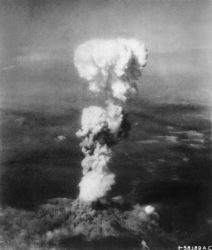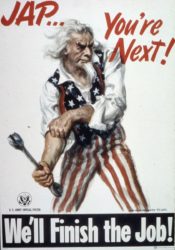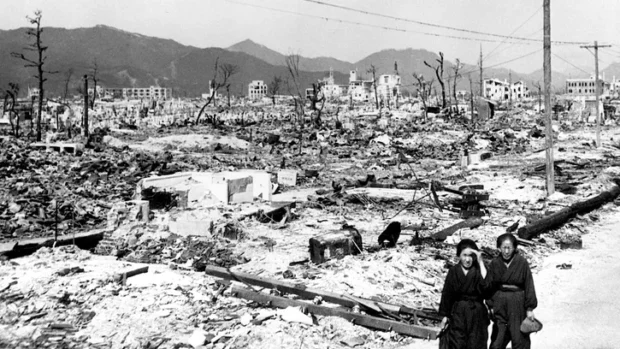Originally posted on August 6, 2020; updated August 6, 2022]
On August 6, 1945, the atomic bomb was dropped on Hiroshima. At 8:15 local time, the first atomic bomb was detonated 1,986 feet above the city.

The atomic bomb cloud over Hiroshima Source: National Archives https://catalog.archives.gov/id/542192
Hiroshima before the war was the seventh largest city in Japan, with a population of over 340,000, and was the principal administrative and commercial center of the southwestern part of the country. As the headquarters of the Second Army and of the Chugoku Regional Army, it was one of the most important military command stations in Japan, the site of one of the largest military supply depots, and the foremost military shipping point for both troops and supplies.
Shortly afterwards, the White House released a statement from President Harry S. Truman that had been drafted while he was attending the Potsdam Conference. Truman called Hiroshima “an important Japanese army base.”
We are now prepared to obliterate more rapidly and completely every productive enterprise the Japanese have above ground in any city. We shall destroy their docks, their factories, and their communications. Let there be no mistake; we shall completely destroy Japan’s power to make war.
It was to spare the Japanese people from utter destruction that the ultimatum of July 26 was issued at Potsdam. Their leaders promptly rejected that ultimatum. If they do not now accept our terms they may expect a rain of ruin from the air, the like of which has never been seen on this earth. Behind this air attack will follow sea and land forces in such numbers and power as they have not yet seen and with the fighting skill of which they are already well aware.
Read: The Month That Changed the World for a timeline of events leading up to the end of World War II.

By June 1, Truman had apparently made his decision to use the atomic bomb to end the war with Japan. But the bomb had not yet been tested. Once the bomb had been successfully detonated in the New Mexico desert, the decision to use it moved forward, a fateful choice that was set against the recent American experience on Okinawa, where more than 12,500 Americans and more than 100,000 Japanese had died in brutal combat.
When the Japanese said they would fight to the death rather than make an unconditional surrender, the final decision was cast. Winston Churchill later summarized the decision: “To avert a vast, indefinite butchery.”
-From Don’t Know Much About the American Presidents

Aftermath of atomic bomb (Image: US Dept. of Energy”
After the war, a United States survey team assessed the impact of the Hiroshima bomb.
“Practically the entire densely or moderately built-up portion of the city was leveled by blast and swept by fire. A ‘fire-storm’, a phenomenon which has occurred infrequently in other conflagrations, developed in Hiroshima: fires springing up almost simultaneously over the wide flat area around the center of the city drew in air from all directions. The inrush of air easily overcame the natural ground wind, which had a maximum velocity of 30 to 40 miles per hour two to three hours after the explosion. The ‘fire-wind’ and the symmetry of the built-up center of the city gave a roughly circular shape to the 4.4 square miles which were almost completely burned out.
The surprise, the collapse of many buildings, and the conflagration contributed to an unprecedented casualty rate. Seventy to eighty thousand people were killed, or missing and presumed dead, and an equal number were injured. (Emphasis added)
What history has confirmed is that some of the men who created the bomb didn’t understand how horrifying its capabilities were. Of course, they understood the destructive power of the bomb, but radiation’s dangers were far less understood. As author Peter Wyden tells it in Day One, an account of the making and dropping of the bomb, scientists involved in creating what they called “the gadget” believed that anyone who might be killed by radiation would die from falling bricks first.
“The survivors, known as hibakusha, sought relief from their injuries. However, 90 percent of all medical personnel were killed or disabled, and the remaining medical supplies quickly ran out. Many survivors began to notice the effects of exposure to the bomb’s radiation. Their symptoms ranged from nausea, bleeding and loss of hair, to death. Flash burns, a susceptibility to leukemia, cataracts and malignant tumors were some of the other effects.
–“The Story of Hiroshima,” Hiroshima and Nagasaki Remembered
The heat was tremendous . And I felt like my body was burning all over. For my burning body the cold water of the river was as precious as the treasure. Then I left the river, and I walked along the railroad tracks in the direction of my home. On the way, I ran into an another friend of mine, Tokujiro Hatta. I wondered why the soles of his feet were badly burnt. It was unthinkable to get burned there. But it was undeniable fact the soles were peeling and red muscle was exposed.
—Mr. Akihiro Takahashi, who was 14 years old, when the bomb was dropped
On August 9, a second bomb, code named Fat Man, was detonated above Nagasaki.
Like Hiroshima, the immediate aftermath in Nagasaki was a nightmare. More than forty percent of the city was destroyed. Major hospitals had been utterly flattened and care for the injured was impossible. Schools, churches, and homes had simply disappeared. Transportation was impossible.
Many historians contend that preventing death and casualties in an invasion of Japan was only a partial explanation for the use of the two atomic bombs. The United States was already wary of Stalin and his designs on Japan’s wartime territory. They argue that the use of the two devices was meant to end the war quickly to prevent Stalin from capturing territory held by Japan. It may have also been a signal to Stalin and the Soviet Union –which had declared war on Japan and moved troops into Manchuria– that the United States possessed these weapons and was willing to use them.
In other words, the dropping of the atomic bombs became the first volley in the Cold War.
August 6 and 9 should not be days to argue about the politics of the bomb. They should be days of solemn remembrance of the victims. And of contemplating the horrific power of the weapons we create.
The City of Hiroshima Peace Memorial Park and Museum offers an English language website with a history of Hiroshima and the effects of the bombing.
Photo of what became later Hiroshima Peace Memorial among the ruins of buildings in Hiroshima, in early October, 1945, photo by Shigeo Hayashi. (Source Wikimedia Commons)
In 1939, physicist Albert Einstein had written a letter to President Franklin D. Roosevelt that resulted in the creation of the Manhattan Project that developed the atomic bomb. In 1948, Einstein was quoted by an interviewer as saying:
If I had foreseen Hiroshima and Nagasaki, I would have torn up my formula in 1905.
-Quoted in Einstein and the Poet : In Search of the Cosmic Man (1983) by William Hermanns
In 2016, President Barack Obama became the first sitting U.S. President to visit Hiroshima.